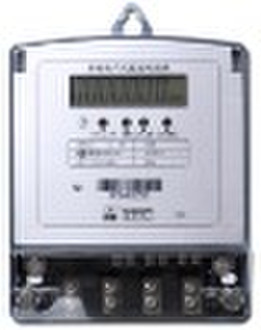Single Phase Static Carrier Wave Energy Meter (N,N
深圳宝安国际机场, 中国

Elva Wan
联系人姓名
基本信息
| 展览的类型 | 只是模拟 |
|---|---|
| 阶段 | 单独一个阶段 |
| 出生地 | Guangdong China (Mainland) |
| 牌子的名字 | LDE |
| 模式的数量 | DDSI51N |
| 衡量能源的范围 | 1.2W/10VA |
| 准确性的课 | CL 1.0/2.0 |
| 产出电压 | 220V |
| 工作温度 | -25C to +55C |
1. Summary DDSI51N Series Single Phase Static Carrier Wave Energy Meter, with infrared/PLC communication, LCD display and relay control (optional) etc, is particularly suitable for measuring energy consumption of residential and industrial users with remote control function. DDSI51N Series Single Phase Static Carrier Wave Energy Meter confirms to: CEI IEC62052-11-2003 Electricity metering equipment (a.c.) General requirements, tests and test conditions Part 11: Metering equipment CEI IEC62053-21-2003 Electricity metering equipment (a.c.) Particular requirements Part 21: Static meters for active energy (classes 1 and 2) equipment DL/T698-1999 Low voltage AMR system technical requirements JJG596-1999 Static energy meter inspection rules DL/T 830-2002 Static single phase a.c. energy meter operation guide 2. Functions and Features 2.1 Calendar with auto switch in leap year 2.2 Energy info of latest 48hours, 7days and 3 months can be stored automatically 2.3 Positive active energy display in LCD (6 integers, 1 decimal) 2.4 Meter programming and reading such as real-time energy, monthly frozen energy, daily frozen energy, hourly frozen energy, meter ID, date&time, meter status word etc. can be achieved via infrared and PLC communication 2.5 Remote relay control with LED indication (optional) 2.6 Broadcast time synchronization 2.7 Real-time total energy can be displayed under no energy 3. Technical Specifications Items Technical Parameters Rated voltage 220V Basic current 1.5(6)A,5(20)A ,10(40)A,15(60)A ,20(80)A Frequency 50Hz Accuracy CL 1.0/2.0 Start current 0.4%Ib(CL1.0); 0.5%Ib(CL2.0) Running with no load Yes Power burden ≤1.2W/10VA(voltage circuits, no communicating ); ≤1VA(current circuits) Normal operating temp. -25∼+55 Limit operating temp. -40∼+70 RH ≤75% Data store ≥10 years Communication channelBidirectional infrared and low-voltage PLC communication
-
支付方式
我们接受:









